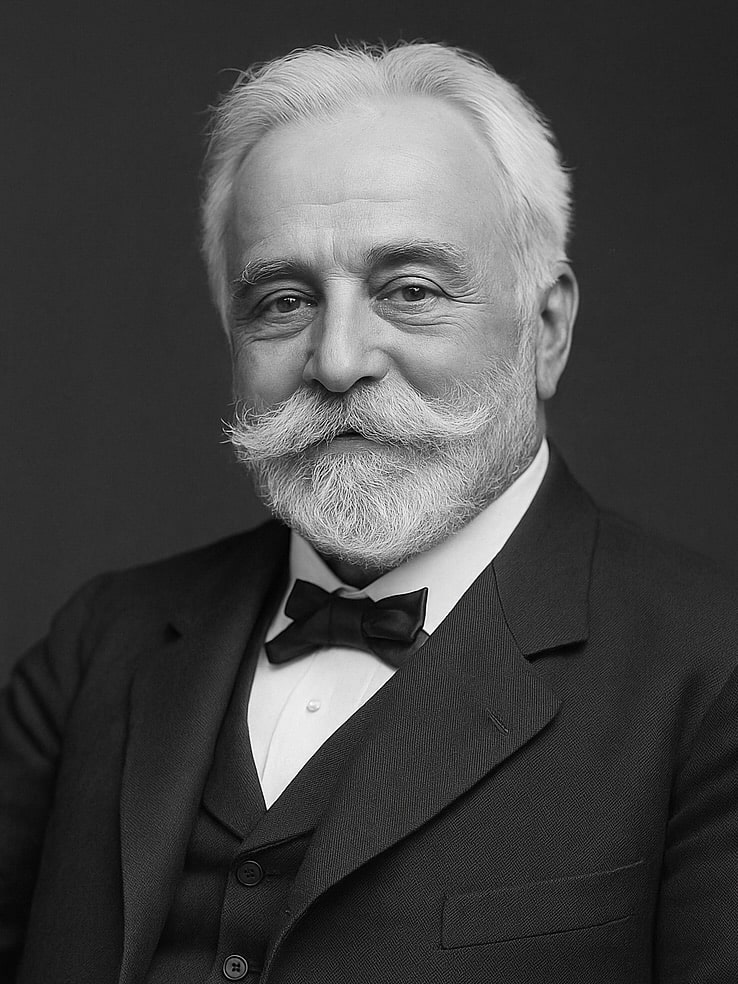Auguste Millard

Auguste Louis Jules Millard (1830-1915) was a French physician
Millard contributed to the study of vascular accidents affecting the brain stem, which led to the eponymous Millard-Gubler syndrome (1856), a condition characterized by crossed hemiplegia and named after himself and Adolphe-Marie Gubler (1821-1879)
For nearly half a century, Millard had the exceptional and deserved honour of being, for generations of physicians, the great friend, the trusted advisor of the medical-surgical and obstetrical profession; a living model of professional integrity, and dedication. He devoted every day of his professional life to his hospital duties. His kindness, soon to become legendary, and his affability made him the most popular Master among all younger generations of students. [Nécrologie A. Millard, 1915]
Biography
- Born on June 30, 1830 in Paris
- 1854 – membre Société anatomique de Paris
- 1860 – physician to the Bureau central des hôpitaux de Paris
- 1865-1876 working as physician in Hôpital des Enfants-Malades, Hôpital St. Antoine and Hôpital Lariboisière in Paris
- 1877-1895 Hôpital Beaujon
- Died on November 13, 1915 in Paris
…la mort a emporté l’une des figures les plus sympathiques et les plus aimées du monde médical parisien.
Il suffisait de voir, une seule fois, ce beau visage, aux traits fins et à la douceur souriante, orné, dès sa jeunesse, d’une chevelure abondante et d’une barbe blanche éclatante, pour ne jamais l’oublier.
…death robbed us of one of the most sympathetic and beloved figures in the Parisian medical world. One only had to see, once, that handsome face, with its fine features and gentle smile, adorned, from his youth, with abundant hair and a dazzling white beard, to never forget it.
Medical Eponyms
Millard-Gubler syndrome (1856)
[*aka Gubler paralysis, Gubler syndrome] A pontine lesion affecting the seventh cranial nerve nucleus and the descending pyramidal fibres on one side of the ventral pons, causing homolateral facial paresis and contralateral hemiplegia.
1855 – Auguste Millard (1830-1915) in a brief publication, first proposed to the Société anatomique de Paris that direct facial hemiplegia accompanied by contralateral hemiplegia was a sign of pontine haemorrhage. “L’hémiplégie du mouvement du côté opposé à répanchement et l’hémiplégie faciale directe.”
1856 – Millard provided further description of two patients with ipsilateral facial hemiplegia accompanied by contralateral hemiplegia and pontine haemorrhage. Firstly a patient of Poisson’s and secondly a case reported by Sénac of a fruit and vegetable merchant whose autopsy revealed a 5mm midpontine area of bluish-black softening that contained an “almond-sized” haemorrhagic center.
1856 – Adolphe Gubler (1821-1897) described six additional cases and reviewed pontine neuroanatomy, including purported evidence for decussation of the facial motor fibres. Gubler’s first patient was a woman with pulmonary TB, a right hemiparesis, and left facial weakness. Autopsy revealed a firm mass about the size of “a husked filbert” (12 to 15 mm in diameter) that invaded both sides of the pons but destroyed more of the left side. The seventh-nerve fibres emerging from the pons were “little if at all impaired.”
His other cases were similar, including one first reported by Grenet of a 34-year-old man with left facial paralysis and anaesthesia associated with right hemiparesis and hemianaesthesia.
In an addendum to Gubler’s article, Millard requested that his two cases be reprinted, for he agreed with Gubler that “crossed facial hemiplegia” was a sign of pontine lesions. An attached editor’s note indicated that Gubler had acknowledged Millard as the first to recognize a possible relationship between “direct facial hemiplegia” and pontine lesions. This admission and Millard’s correspondence explain the attachment of Millard’s name to Gubler’s.
1893 – Jean-Martin Charcot (1825-1893) referred to “la paralysie alterne de Gubler” but also acknowledged Millard’s discovery occurring around the same time and justified the use of both names in the eponym.the eponymic use of both names.
Major Publications
- Millard A. Extrait du Rapport. Bulletins de la Société anatomique de Paris. 1855; 30: 206-207
- Millard A. Extrait du rapport de M. Millard sur les observations précédentes. Bulletins de la Société anatomique de Paris. 1856; 31: 217-221. [Millard-Gubler syndrome]
- Millard A. A monsieur le redacteur en chef de la Gazette Hebdomadaire. Gazette hebdomadaire de médecine et de chirurgie. 1856; 3: 816-818.
- Millard A. De la trachéotomie dans le cas de croup : observations recueillies à l’hôpital des Enfants Malades, années 1857 et 1858 (1er semestre): thèse pour le doctorat en médecine, présentée et soutenue le 13 août 1858
References
Biography
- Lereboulliet P. Auguste Millard (1830-1915). Paris médical: la semaine du clinicien, 1915; 18,
Eponymous terms
- Gubler A-M. De l’hémiplégie alterne envisagée comme signe de lésion de la protubérance annulaire et comme preuve de la décussation des nerfs faciaux. Gazette hebdomadaire de médecine et de chirurgie. 1856; 3: 749-754, 789-792, 811-816. [Millard-Gubler syndrome]
- Charcot J-M. Le syndrome de Benedikt. Médecine moderne, 1e mars 1893, p. 194.
- Silverman IE, Liu GT, Volpe NJ, Galetta SL. The crossed paralyses. The original brain-stem syndromes of Millard-Gubler, Foville, Weber, and Raymond-Cestan. Arch Neurol. 1995 Jun;52(6):635-8.
Eponym
the person behind the name
